1807NRS Trimester 2 Safe Medication Administration Assessment
VerifiedAdded on 2022/12/18
|12
|3237
|42
Homework Assignment
AI Summary
This assignment provides a comprehensive overview of safe medication administration, addressing key aspects such as the regulatory framework in Australia managed by the Therapeutic Goods Administration (TGA) and the processes of clinical trials. It explores the principles of pharmacokinetics and pharmacodynamics, explaining drug absorption, distribution, metabolism, and excretion, as well as the drug's action on the body. The assignment also details the roles and responsibilities of healthcare professionals like nurses, doctors, and pharmacists in the medication cycle, including prescribing, dispensing, and administration. It also includes the importance of patient education, using the example of Glyceryl Trinitrate (GTN). Moreover, it outlines the medication management cycle, encompassing nine crucial steps from prescription to transfer of information. The document further examines factors contributing to medication errors, differentiating between human and system-based errors, and provides preventative strategies to reduce their occurrence, emphasizing the importance of defensive layers and safeguards. Finally, it discusses factors contributing to medication errors and preventative strategies to reduce the likelihood of error such as overcrowding and lack of pharmacist rechecking.
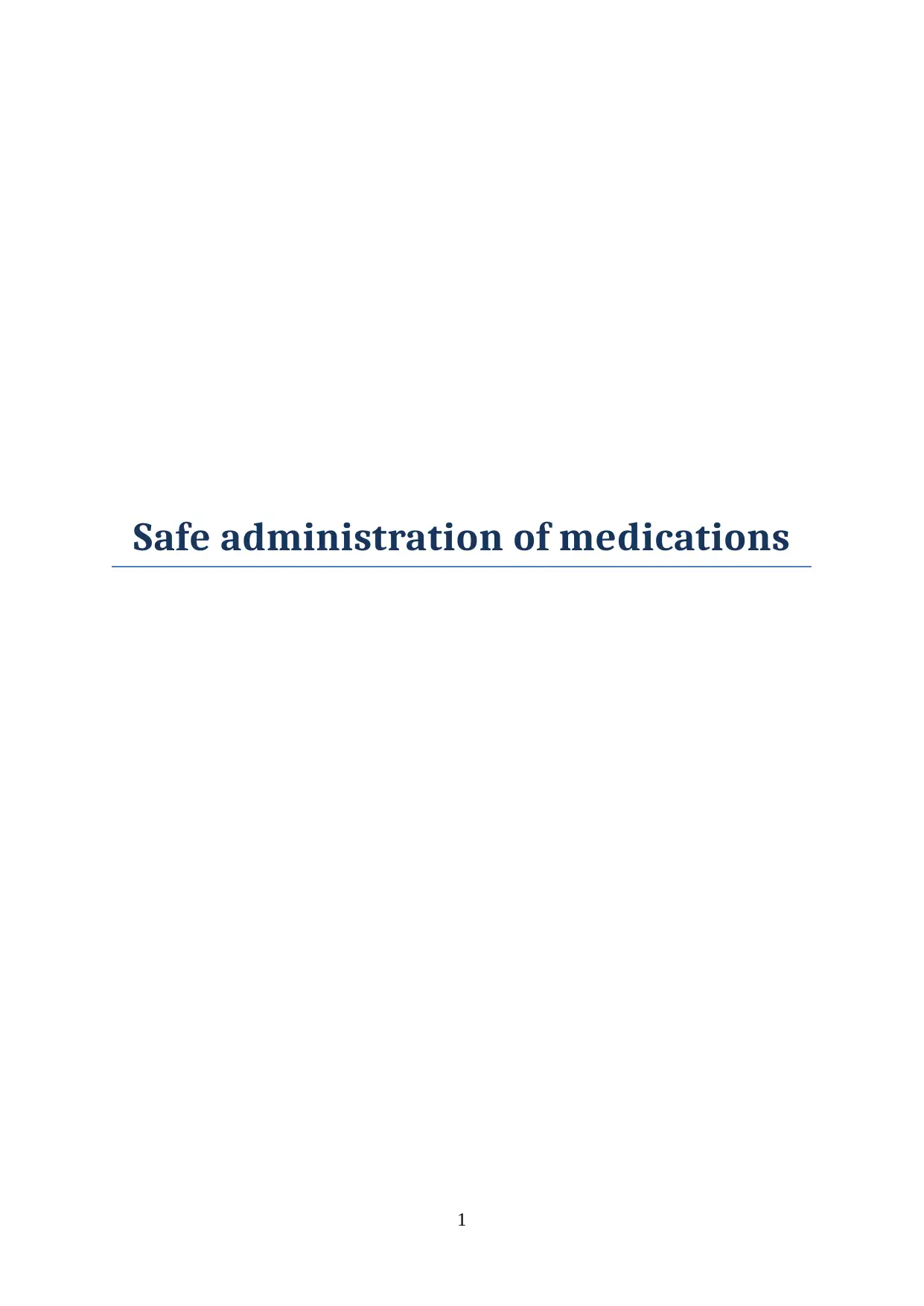
Safe administration of medications
1
1
Paraphrase This Document
Need a fresh take? Get an instant paraphrase of this document with our AI Paraphraser
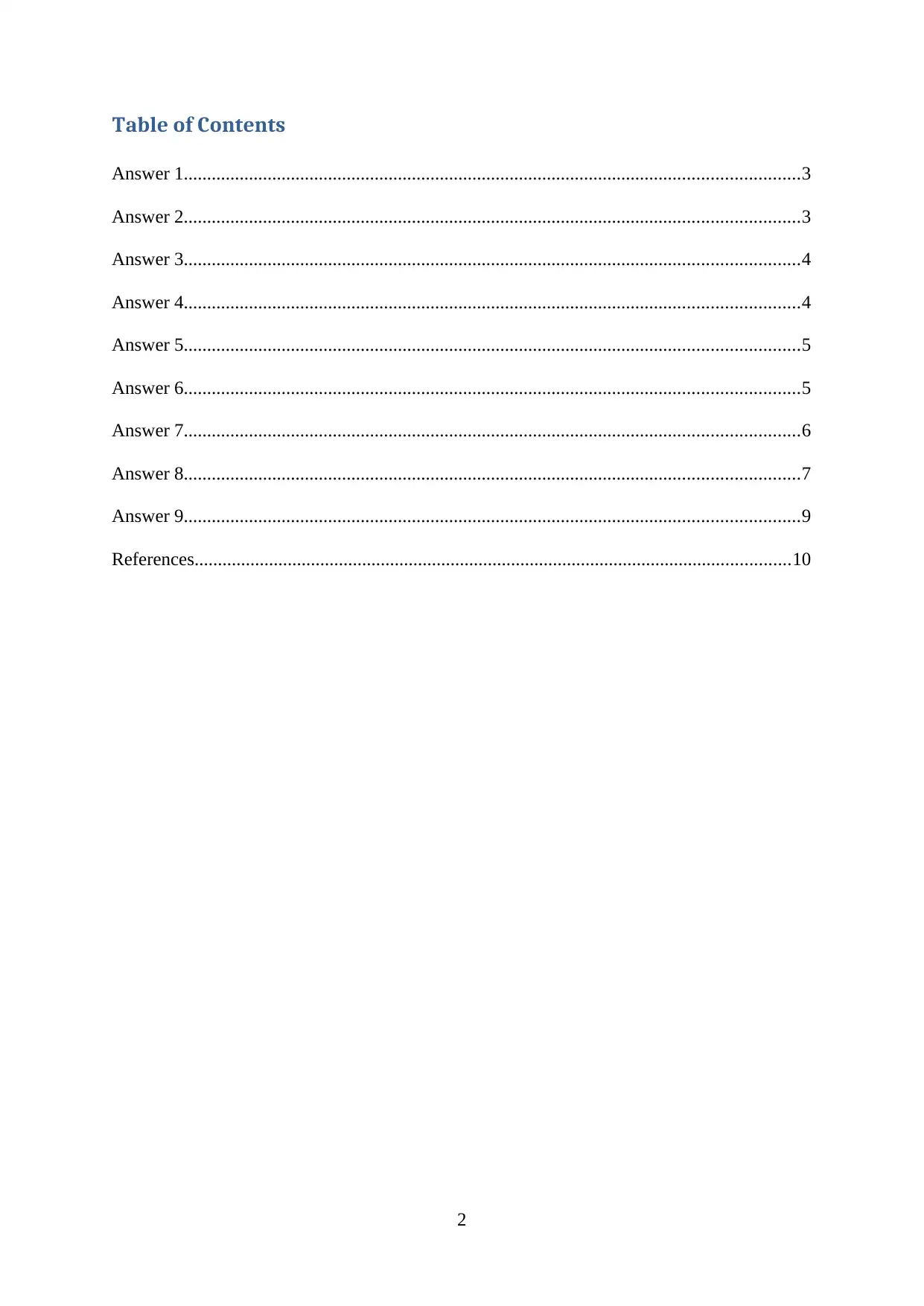
Table of Contents
Answer 1....................................................................................................................................3
Answer 2....................................................................................................................................3
Answer 3....................................................................................................................................4
Answer 4....................................................................................................................................4
Answer 5....................................................................................................................................5
Answer 6....................................................................................................................................5
Answer 7....................................................................................................................................6
Answer 8....................................................................................................................................7
Answer 9....................................................................................................................................9
References................................................................................................................................10
2
Answer 1....................................................................................................................................3
Answer 2....................................................................................................................................3
Answer 3....................................................................................................................................4
Answer 4....................................................................................................................................4
Answer 5....................................................................................................................................5
Answer 6....................................................................................................................................5
Answer 7....................................................................................................................................6
Answer 8....................................................................................................................................7
Answer 9....................................................................................................................................9
References................................................................................................................................10
2
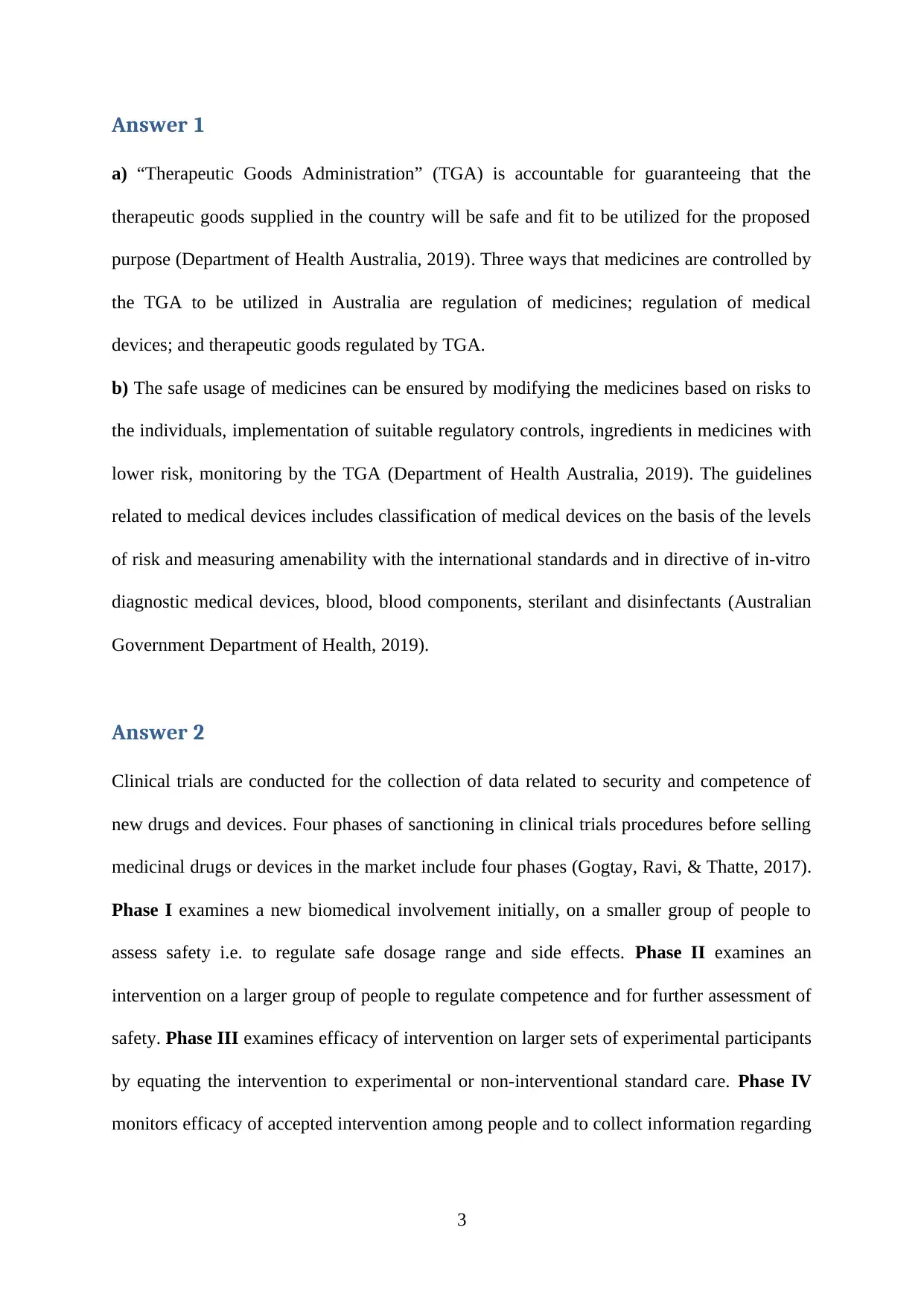
Answer 1
a) “Therapeutic Goods Administration” (TGA) is accountable for guaranteeing that the
therapeutic goods supplied in the country will be safe and fit to be utilized for the proposed
purpose (Department of Health Australia, 2019). Three ways that medicines are controlled by
the TGA to be utilized in Australia are regulation of medicines; regulation of medical
devices; and therapeutic goods regulated by TGA.
b) The safe usage of medicines can be ensured by modifying the medicines based on risks to
the individuals, implementation of suitable regulatory controls, ingredients in medicines with
lower risk, monitoring by the TGA (Department of Health Australia, 2019). The guidelines
related to medical devices includes classification of medical devices on the basis of the levels
of risk and measuring amenability with the international standards and in directive of in-vitro
diagnostic medical devices, blood, blood components, sterilant and disinfectants (Australian
Government Department of Health, 2019).
Answer 2
Clinical trials are conducted for the collection of data related to security and competence of
new drugs and devices. Four phases of sanctioning in clinical trials procedures before selling
medicinal drugs or devices in the market include four phases (Gogtay, Ravi, & Thatte, 2017).
Phase I examines a new biomedical involvement initially, on a smaller group of people to
assess safety i.e. to regulate safe dosage range and side effects. Phase II examines an
intervention on a larger group of people to regulate competence and for further assessment of
safety. Phase III examines efficacy of intervention on larger sets of experimental participants
by equating the intervention to experimental or non-interventional standard care. Phase IV
monitors efficacy of accepted intervention among people and to collect information regarding
3
a) “Therapeutic Goods Administration” (TGA) is accountable for guaranteeing that the
therapeutic goods supplied in the country will be safe and fit to be utilized for the proposed
purpose (Department of Health Australia, 2019). Three ways that medicines are controlled by
the TGA to be utilized in Australia are regulation of medicines; regulation of medical
devices; and therapeutic goods regulated by TGA.
b) The safe usage of medicines can be ensured by modifying the medicines based on risks to
the individuals, implementation of suitable regulatory controls, ingredients in medicines with
lower risk, monitoring by the TGA (Department of Health Australia, 2019). The guidelines
related to medical devices includes classification of medical devices on the basis of the levels
of risk and measuring amenability with the international standards and in directive of in-vitro
diagnostic medical devices, blood, blood components, sterilant and disinfectants (Australian
Government Department of Health, 2019).
Answer 2
Clinical trials are conducted for the collection of data related to security and competence of
new drugs and devices. Four phases of sanctioning in clinical trials procedures before selling
medicinal drugs or devices in the market include four phases (Gogtay, Ravi, & Thatte, 2017).
Phase I examines a new biomedical involvement initially, on a smaller group of people to
assess safety i.e. to regulate safe dosage range and side effects. Phase II examines an
intervention on a larger group of people to regulate competence and for further assessment of
safety. Phase III examines efficacy of intervention on larger sets of experimental participants
by equating the intervention to experimental or non-interventional standard care. Phase IV
monitors efficacy of accepted intervention among people and to collect information regarding
3
⊘ This is a preview!⊘
Do you want full access?
Subscribe today to unlock all pages.

Trusted by 1+ million students worldwide
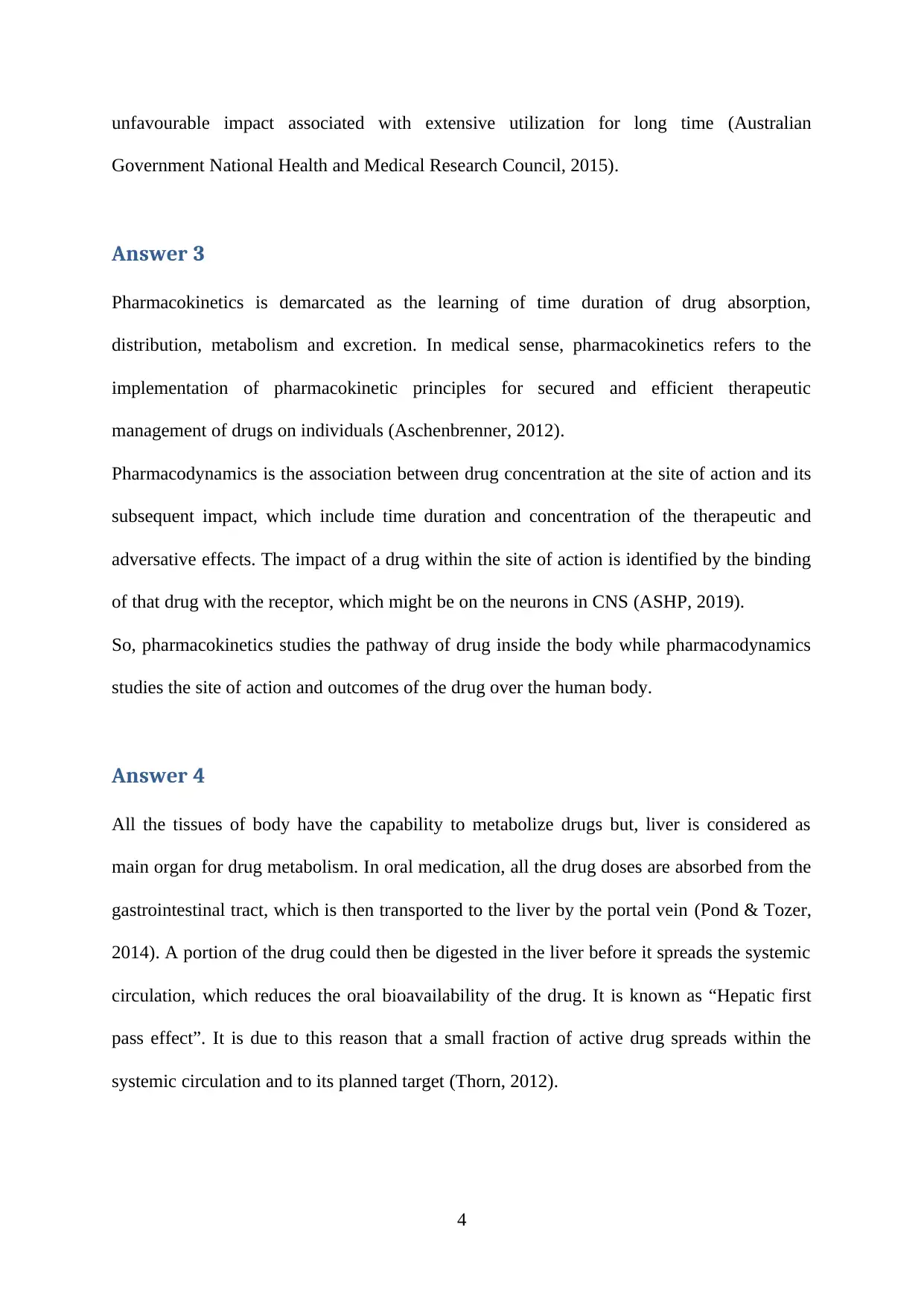
unfavourable impact associated with extensive utilization for long time (Australian
Government National Health and Medical Research Council, 2015).
Answer 3
Pharmacokinetics is demarcated as the learning of time duration of drug absorption,
distribution, metabolism and excretion. In medical sense, pharmacokinetics refers to the
implementation of pharmacokinetic principles for secured and efficient therapeutic
management of drugs on individuals (Aschenbrenner, 2012).
Pharmacodynamics is the association between drug concentration at the site of action and its
subsequent impact, which include time duration and concentration of the therapeutic and
adversative effects. The impact of a drug within the site of action is identified by the binding
of that drug with the receptor, which might be on the neurons in CNS (ASHP, 2019).
So, pharmacokinetics studies the pathway of drug inside the body while pharmacodynamics
studies the site of action and outcomes of the drug over the human body.
Answer 4
All the tissues of body have the capability to metabolize drugs but, liver is considered as
main organ for drug metabolism. In oral medication, all the drug doses are absorbed from the
gastrointestinal tract, which is then transported to the liver by the portal vein (Pond & Tozer,
2014). A portion of the drug could then be digested in the liver before it spreads the systemic
circulation, which reduces the oral bioavailability of the drug. It is known as “Hepatic first
pass effect”. It is due to this reason that a small fraction of active drug spreads within the
systemic circulation and to its planned target (Thorn, 2012).
4
Government National Health and Medical Research Council, 2015).
Answer 3
Pharmacokinetics is demarcated as the learning of time duration of drug absorption,
distribution, metabolism and excretion. In medical sense, pharmacokinetics refers to the
implementation of pharmacokinetic principles for secured and efficient therapeutic
management of drugs on individuals (Aschenbrenner, 2012).
Pharmacodynamics is the association between drug concentration at the site of action and its
subsequent impact, which include time duration and concentration of the therapeutic and
adversative effects. The impact of a drug within the site of action is identified by the binding
of that drug with the receptor, which might be on the neurons in CNS (ASHP, 2019).
So, pharmacokinetics studies the pathway of drug inside the body while pharmacodynamics
studies the site of action and outcomes of the drug over the human body.
Answer 4
All the tissues of body have the capability to metabolize drugs but, liver is considered as
main organ for drug metabolism. In oral medication, all the drug doses are absorbed from the
gastrointestinal tract, which is then transported to the liver by the portal vein (Pond & Tozer,
2014). A portion of the drug could then be digested in the liver before it spreads the systemic
circulation, which reduces the oral bioavailability of the drug. It is known as “Hepatic first
pass effect”. It is due to this reason that a small fraction of active drug spreads within the
systemic circulation and to its planned target (Thorn, 2012).
4
Paraphrase This Document
Need a fresh take? Get an instant paraphrase of this document with our AI Paraphraser
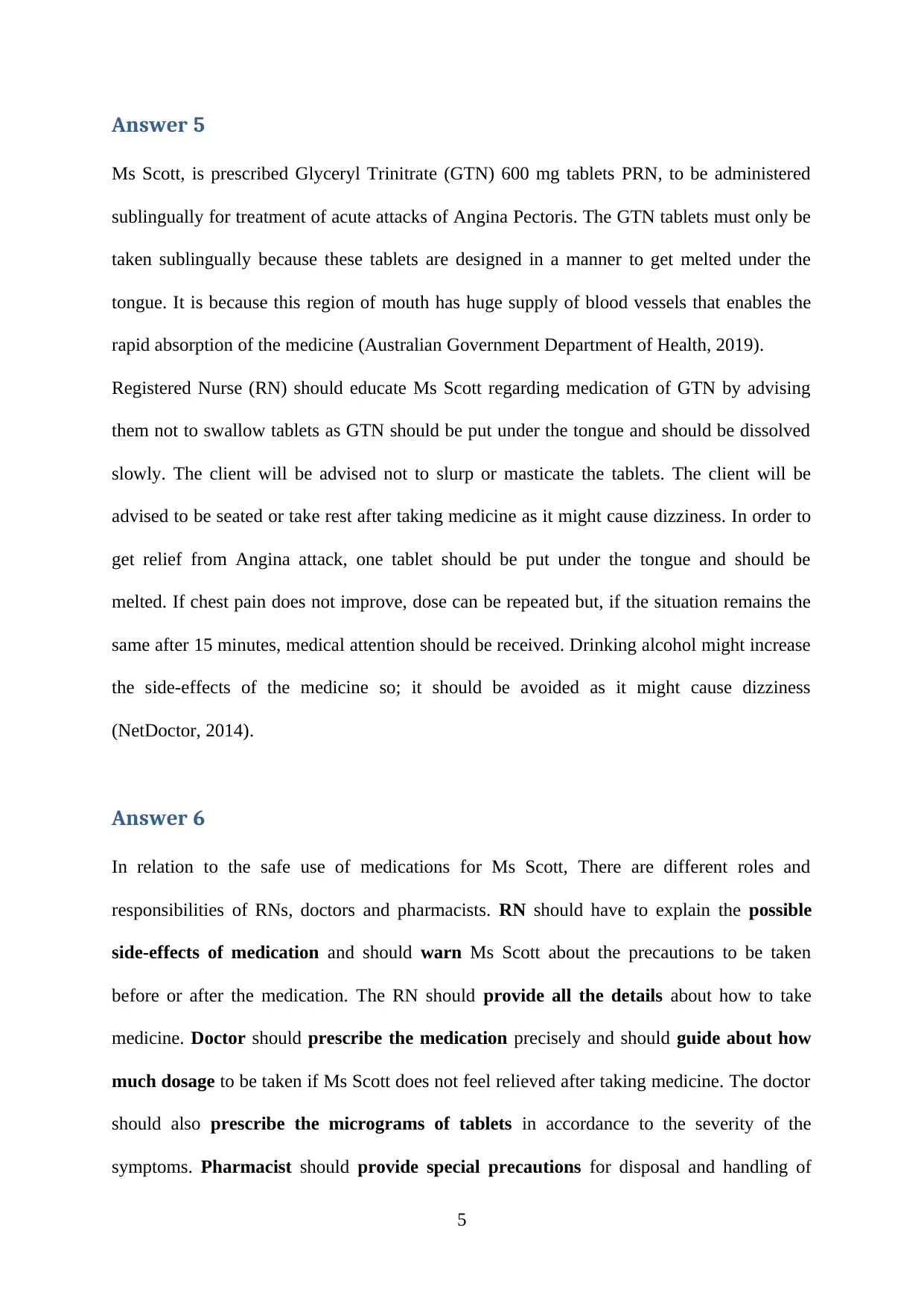
Answer 5
Ms Scott, is prescribed Glyceryl Trinitrate (GTN) 600 mg tablets PRN, to be administered
sublingually for treatment of acute attacks of Angina Pectoris. The GTN tablets must only be
taken sublingually because these tablets are designed in a manner to get melted under the
tongue. It is because this region of mouth has huge supply of blood vessels that enables the
rapid absorption of the medicine (Australian Government Department of Health, 2019).
Registered Nurse (RN) should educate Ms Scott regarding medication of GTN by advising
them not to swallow tablets as GTN should be put under the tongue and should be dissolved
slowly. The client will be advised not to slurp or masticate the tablets. The client will be
advised to be seated or take rest after taking medicine as it might cause dizziness. In order to
get relief from Angina attack, one tablet should be put under the tongue and should be
melted. If chest pain does not improve, dose can be repeated but, if the situation remains the
same after 15 minutes, medical attention should be received. Drinking alcohol might increase
the side-effects of the medicine so; it should be avoided as it might cause dizziness
(NetDoctor, 2014).
Answer 6
In relation to the safe use of medications for Ms Scott, There are different roles and
responsibilities of RNs, doctors and pharmacists. RN should have to explain the possible
side-effects of medication and should warn Ms Scott about the precautions to be taken
before or after the medication. The RN should provide all the details about how to take
medicine. Doctor should prescribe the medication precisely and should guide about how
much dosage to be taken if Ms Scott does not feel relieved after taking medicine. The doctor
should also prescribe the micrograms of tablets in accordance to the severity of the
symptoms. Pharmacist should provide special precautions for disposal and handling of
5
Ms Scott, is prescribed Glyceryl Trinitrate (GTN) 600 mg tablets PRN, to be administered
sublingually for treatment of acute attacks of Angina Pectoris. The GTN tablets must only be
taken sublingually because these tablets are designed in a manner to get melted under the
tongue. It is because this region of mouth has huge supply of blood vessels that enables the
rapid absorption of the medicine (Australian Government Department of Health, 2019).
Registered Nurse (RN) should educate Ms Scott regarding medication of GTN by advising
them not to swallow tablets as GTN should be put under the tongue and should be dissolved
slowly. The client will be advised not to slurp or masticate the tablets. The client will be
advised to be seated or take rest after taking medicine as it might cause dizziness. In order to
get relief from Angina attack, one tablet should be put under the tongue and should be
melted. If chest pain does not improve, dose can be repeated but, if the situation remains the
same after 15 minutes, medical attention should be received. Drinking alcohol might increase
the side-effects of the medicine so; it should be avoided as it might cause dizziness
(NetDoctor, 2014).
Answer 6
In relation to the safe use of medications for Ms Scott, There are different roles and
responsibilities of RNs, doctors and pharmacists. RN should have to explain the possible
side-effects of medication and should warn Ms Scott about the precautions to be taken
before or after the medication. The RN should provide all the details about how to take
medicine. Doctor should prescribe the medication precisely and should guide about how
much dosage to be taken if Ms Scott does not feel relieved after taking medicine. The doctor
should also prescribe the micrograms of tablets in accordance to the severity of the
symptoms. Pharmacist should provide special precautions for disposal and handling of
5
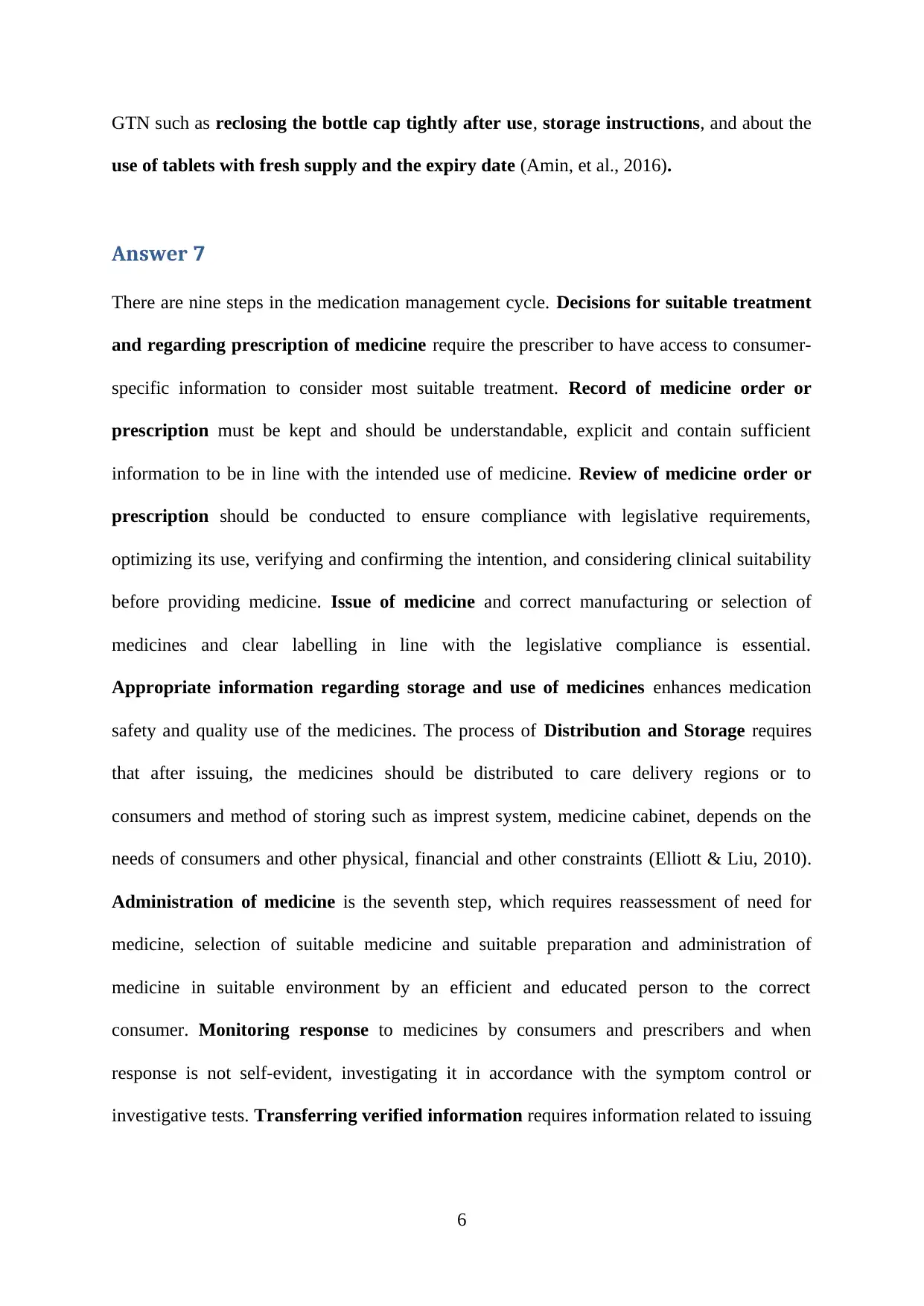
GTN such as reclosing the bottle cap tightly after use, storage instructions, and about the
use of tablets with fresh supply and the expiry date (Amin, et al., 2016).
Answer 7
There are nine steps in the medication management cycle. Decisions for suitable treatment
and regarding prescription of medicine require the prescriber to have access to consumer-
specific information to consider most suitable treatment. Record of medicine order or
prescription must be kept and should be understandable, explicit and contain sufficient
information to be in line with the intended use of medicine. Review of medicine order or
prescription should be conducted to ensure compliance with legislative requirements,
optimizing its use, verifying and confirming the intention, and considering clinical suitability
before providing medicine. Issue of medicine and correct manufacturing or selection of
medicines and clear labelling in line with the legislative compliance is essential.
Appropriate information regarding storage and use of medicines enhances medication
safety and quality use of the medicines. The process of Distribution and Storage requires
that after issuing, the medicines should be distributed to care delivery regions or to
consumers and method of storing such as imprest system, medicine cabinet, depends on the
needs of consumers and other physical, financial and other constraints (Elliott & Liu, 2010).
Administration of medicine is the seventh step, which requires reassessment of need for
medicine, selection of suitable medicine and suitable preparation and administration of
medicine in suitable environment by an efficient and educated person to the correct
consumer. Monitoring response to medicines by consumers and prescribers and when
response is not self-evident, investigating it in accordance with the symptom control or
investigative tests. Transferring verified information requires information related to issuing
6
use of tablets with fresh supply and the expiry date (Amin, et al., 2016).
Answer 7
There are nine steps in the medication management cycle. Decisions for suitable treatment
and regarding prescription of medicine require the prescriber to have access to consumer-
specific information to consider most suitable treatment. Record of medicine order or
prescription must be kept and should be understandable, explicit and contain sufficient
information to be in line with the intended use of medicine. Review of medicine order or
prescription should be conducted to ensure compliance with legislative requirements,
optimizing its use, verifying and confirming the intention, and considering clinical suitability
before providing medicine. Issue of medicine and correct manufacturing or selection of
medicines and clear labelling in line with the legislative compliance is essential.
Appropriate information regarding storage and use of medicines enhances medication
safety and quality use of the medicines. The process of Distribution and Storage requires
that after issuing, the medicines should be distributed to care delivery regions or to
consumers and method of storing such as imprest system, medicine cabinet, depends on the
needs of consumers and other physical, financial and other constraints (Elliott & Liu, 2010).
Administration of medicine is the seventh step, which requires reassessment of need for
medicine, selection of suitable medicine and suitable preparation and administration of
medicine in suitable environment by an efficient and educated person to the correct
consumer. Monitoring response to medicines by consumers and prescribers and when
response is not self-evident, investigating it in accordance with the symptom control or
investigative tests. Transferring verified information requires information related to issuing
6
⊘ This is a preview!⊘
Do you want full access?
Subscribe today to unlock all pages.

Trusted by 1+ million students worldwide
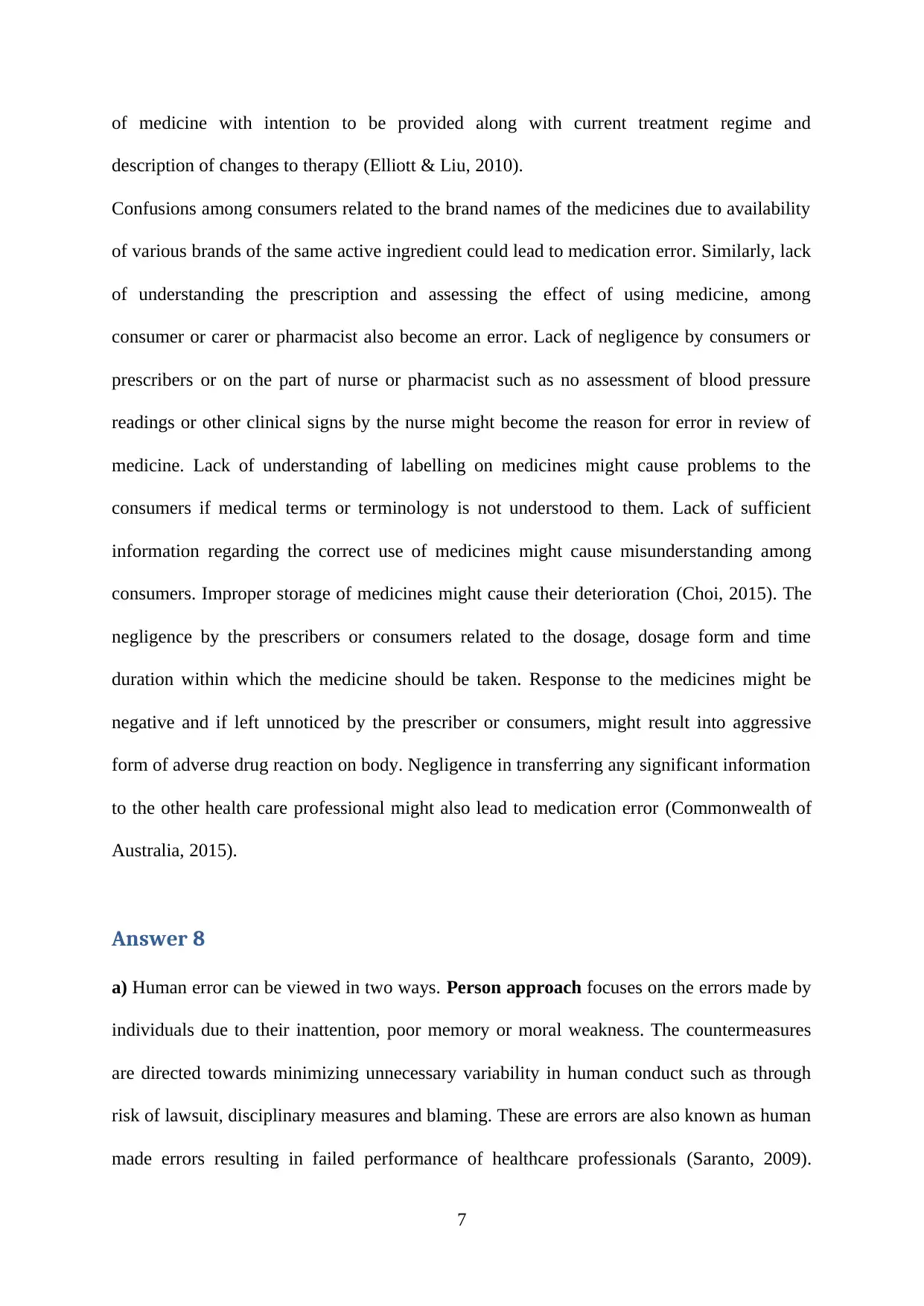
of medicine with intention to be provided along with current treatment regime and
description of changes to therapy (Elliott & Liu, 2010).
Confusions among consumers related to the brand names of the medicines due to availability
of various brands of the same active ingredient could lead to medication error. Similarly, lack
of understanding the prescription and assessing the effect of using medicine, among
consumer or carer or pharmacist also become an error. Lack of negligence by consumers or
prescribers or on the part of nurse or pharmacist such as no assessment of blood pressure
readings or other clinical signs by the nurse might become the reason for error in review of
medicine. Lack of understanding of labelling on medicines might cause problems to the
consumers if medical terms or terminology is not understood to them. Lack of sufficient
information regarding the correct use of medicines might cause misunderstanding among
consumers. Improper storage of medicines might cause their deterioration (Choi, 2015). The
negligence by the prescribers or consumers related to the dosage, dosage form and time
duration within which the medicine should be taken. Response to the medicines might be
negative and if left unnoticed by the prescriber or consumers, might result into aggressive
form of adverse drug reaction on body. Negligence in transferring any significant information
to the other health care professional might also lead to medication error (Commonwealth of
Australia, 2015).
Answer 8
a) Human error can be viewed in two ways. Person approach focuses on the errors made by
individuals due to their inattention, poor memory or moral weakness. The countermeasures
are directed towards minimizing unnecessary variability in human conduct such as through
risk of lawsuit, disciplinary measures and blaming. These are errors are also known as human
made errors resulting in failed performance of healthcare professionals (Saranto, 2009).
7
description of changes to therapy (Elliott & Liu, 2010).
Confusions among consumers related to the brand names of the medicines due to availability
of various brands of the same active ingredient could lead to medication error. Similarly, lack
of understanding the prescription and assessing the effect of using medicine, among
consumer or carer or pharmacist also become an error. Lack of negligence by consumers or
prescribers or on the part of nurse or pharmacist such as no assessment of blood pressure
readings or other clinical signs by the nurse might become the reason for error in review of
medicine. Lack of understanding of labelling on medicines might cause problems to the
consumers if medical terms or terminology is not understood to them. Lack of sufficient
information regarding the correct use of medicines might cause misunderstanding among
consumers. Improper storage of medicines might cause their deterioration (Choi, 2015). The
negligence by the prescribers or consumers related to the dosage, dosage form and time
duration within which the medicine should be taken. Response to the medicines might be
negative and if left unnoticed by the prescriber or consumers, might result into aggressive
form of adverse drug reaction on body. Negligence in transferring any significant information
to the other health care professional might also lead to medication error (Commonwealth of
Australia, 2015).
Answer 8
a) Human error can be viewed in two ways. Person approach focuses on the errors made by
individuals due to their inattention, poor memory or moral weakness. The countermeasures
are directed towards minimizing unnecessary variability in human conduct such as through
risk of lawsuit, disciplinary measures and blaming. These are errors are also known as human
made errors resulting in failed performance of healthcare professionals (Saranto, 2009).
7
Paraphrase This Document
Need a fresh take? Get an instant paraphrase of this document with our AI Paraphraser
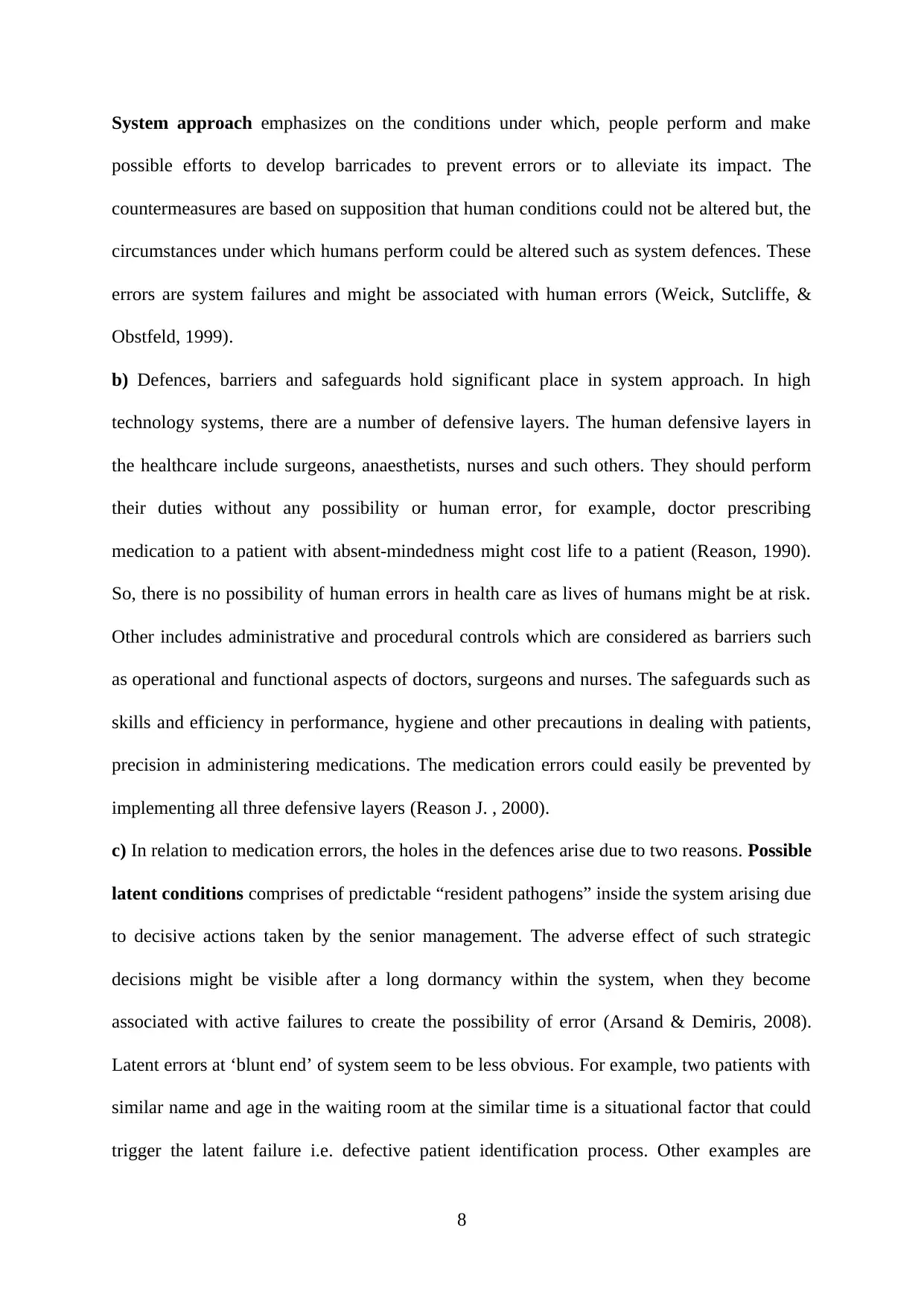
System approach emphasizes on the conditions under which, people perform and make
possible efforts to develop barricades to prevent errors or to alleviate its impact. The
countermeasures are based on supposition that human conditions could not be altered but, the
circumstances under which humans perform could be altered such as system defences. These
errors are system failures and might be associated with human errors (Weick, Sutcliffe, &
Obstfeld, 1999).
b) Defences, barriers and safeguards hold significant place in system approach. In high
technology systems, there are a number of defensive layers. The human defensive layers in
the healthcare include surgeons, anaesthetists, nurses and such others. They should perform
their duties without any possibility or human error, for example, doctor prescribing
medication to a patient with absent-mindedness might cost life to a patient (Reason, 1990).
So, there is no possibility of human errors in health care as lives of humans might be at risk.
Other includes administrative and procedural controls which are considered as barriers such
as operational and functional aspects of doctors, surgeons and nurses. The safeguards such as
skills and efficiency in performance, hygiene and other precautions in dealing with patients,
precision in administering medications. The medication errors could easily be prevented by
implementing all three defensive layers (Reason J. , 2000).
c) In relation to medication errors, the holes in the defences arise due to two reasons. Possible
latent conditions comprises of predictable “resident pathogens” inside the system arising due
to decisive actions taken by the senior management. The adverse effect of such strategic
decisions might be visible after a long dormancy within the system, when they become
associated with active failures to create the possibility of error (Arsand & Demiris, 2008).
Latent errors at ‘blunt end’ of system seem to be less obvious. For example, two patients with
similar name and age in the waiting room at the similar time is a situational factor that could
trigger the latent failure i.e. defective patient identification process. Other examples are
8
possible efforts to develop barricades to prevent errors or to alleviate its impact. The
countermeasures are based on supposition that human conditions could not be altered but, the
circumstances under which humans perform could be altered such as system defences. These
errors are system failures and might be associated with human errors (Weick, Sutcliffe, &
Obstfeld, 1999).
b) Defences, barriers and safeguards hold significant place in system approach. In high
technology systems, there are a number of defensive layers. The human defensive layers in
the healthcare include surgeons, anaesthetists, nurses and such others. They should perform
their duties without any possibility or human error, for example, doctor prescribing
medication to a patient with absent-mindedness might cost life to a patient (Reason, 1990).
So, there is no possibility of human errors in health care as lives of humans might be at risk.
Other includes administrative and procedural controls which are considered as barriers such
as operational and functional aspects of doctors, surgeons and nurses. The safeguards such as
skills and efficiency in performance, hygiene and other precautions in dealing with patients,
precision in administering medications. The medication errors could easily be prevented by
implementing all three defensive layers (Reason J. , 2000).
c) In relation to medication errors, the holes in the defences arise due to two reasons. Possible
latent conditions comprises of predictable “resident pathogens” inside the system arising due
to decisive actions taken by the senior management. The adverse effect of such strategic
decisions might be visible after a long dormancy within the system, when they become
associated with active failures to create the possibility of error (Arsand & Demiris, 2008).
Latent errors at ‘blunt end’ of system seem to be less obvious. For example, two patients with
similar name and age in the waiting room at the similar time is a situational factor that could
trigger the latent failure i.e. defective patient identification process. Other examples are
8
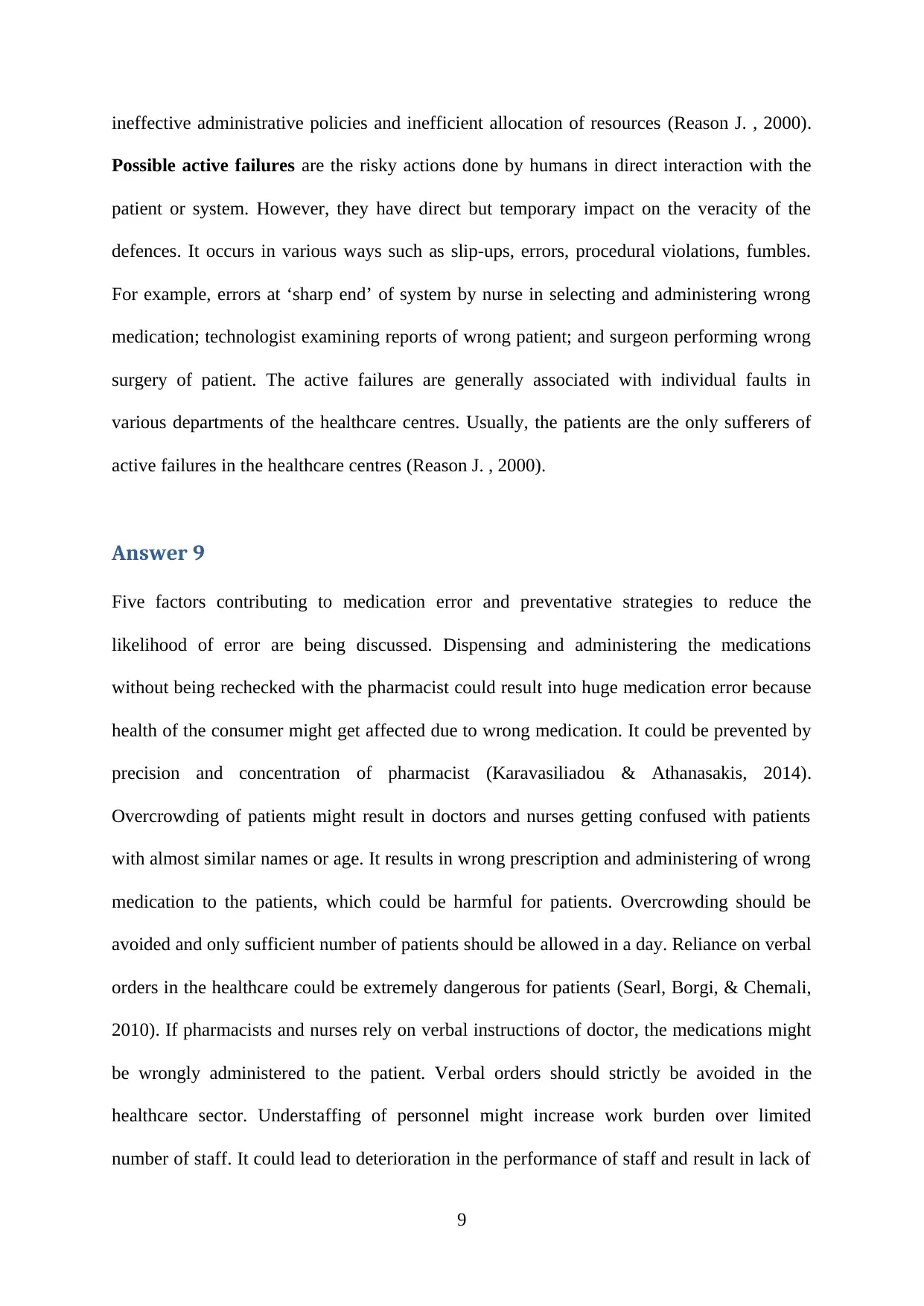
ineffective administrative policies and inefficient allocation of resources (Reason J. , 2000).
Possible active failures are the risky actions done by humans in direct interaction with the
patient or system. However, they have direct but temporary impact on the veracity of the
defences. It occurs in various ways such as slip-ups, errors, procedural violations, fumbles.
For example, errors at ‘sharp end’ of system by nurse in selecting and administering wrong
medication; technologist examining reports of wrong patient; and surgeon performing wrong
surgery of patient. The active failures are generally associated with individual faults in
various departments of the healthcare centres. Usually, the patients are the only sufferers of
active failures in the healthcare centres (Reason J. , 2000).
Answer 9
Five factors contributing to medication error and preventative strategies to reduce the
likelihood of error are being discussed. Dispensing and administering the medications
without being rechecked with the pharmacist could result into huge medication error because
health of the consumer might get affected due to wrong medication. It could be prevented by
precision and concentration of pharmacist (Karavasiliadou & Athanasakis, 2014).
Overcrowding of patients might result in doctors and nurses getting confused with patients
with almost similar names or age. It results in wrong prescription and administering of wrong
medication to the patients, which could be harmful for patients. Overcrowding should be
avoided and only sufficient number of patients should be allowed in a day. Reliance on verbal
orders in the healthcare could be extremely dangerous for patients (Searl, Borgi, & Chemali,
2010). If pharmacists and nurses rely on verbal instructions of doctor, the medications might
be wrongly administered to the patient. Verbal orders should strictly be avoided in the
healthcare sector. Understaffing of personnel might increase work burden over limited
number of staff. It could lead to deterioration in the performance of staff and result in lack of
9
Possible active failures are the risky actions done by humans in direct interaction with the
patient or system. However, they have direct but temporary impact on the veracity of the
defences. It occurs in various ways such as slip-ups, errors, procedural violations, fumbles.
For example, errors at ‘sharp end’ of system by nurse in selecting and administering wrong
medication; technologist examining reports of wrong patient; and surgeon performing wrong
surgery of patient. The active failures are generally associated with individual faults in
various departments of the healthcare centres. Usually, the patients are the only sufferers of
active failures in the healthcare centres (Reason J. , 2000).
Answer 9
Five factors contributing to medication error and preventative strategies to reduce the
likelihood of error are being discussed. Dispensing and administering the medications
without being rechecked with the pharmacist could result into huge medication error because
health of the consumer might get affected due to wrong medication. It could be prevented by
precision and concentration of pharmacist (Karavasiliadou & Athanasakis, 2014).
Overcrowding of patients might result in doctors and nurses getting confused with patients
with almost similar names or age. It results in wrong prescription and administering of wrong
medication to the patients, which could be harmful for patients. Overcrowding should be
avoided and only sufficient number of patients should be allowed in a day. Reliance on verbal
orders in the healthcare could be extremely dangerous for patients (Searl, Borgi, & Chemali,
2010). If pharmacists and nurses rely on verbal instructions of doctor, the medications might
be wrongly administered to the patient. Verbal orders should strictly be avoided in the
healthcare sector. Understaffing of personnel might increase work burden over limited
number of staff. It could lead to deterioration in the performance of staff and result in lack of
9
⊘ This is a preview!⊘
Do you want full access?
Subscribe today to unlock all pages.

Trusted by 1+ million students worldwide
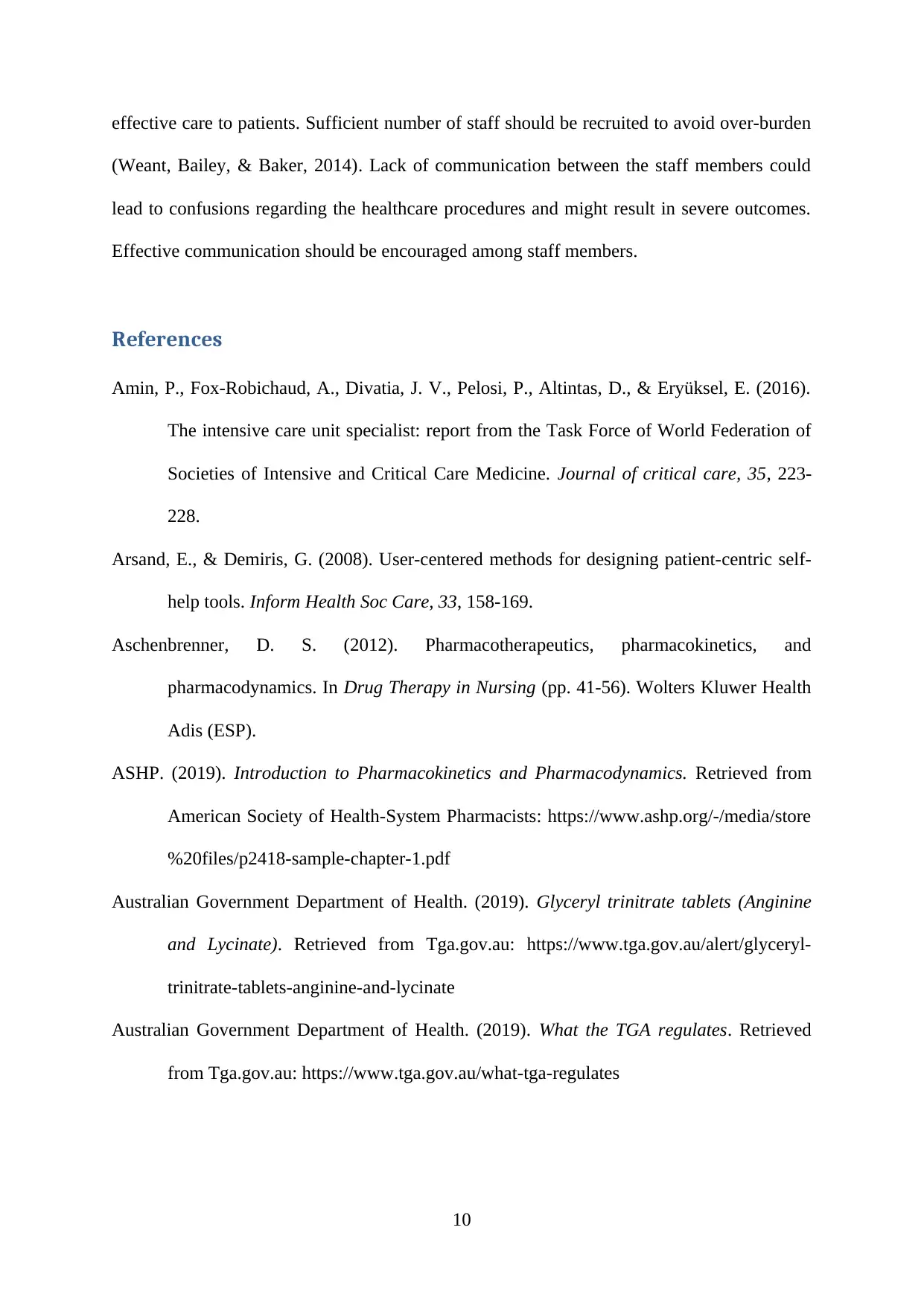
effective care to patients. Sufficient number of staff should be recruited to avoid over-burden
(Weant, Bailey, & Baker, 2014). Lack of communication between the staff members could
lead to confusions regarding the healthcare procedures and might result in severe outcomes.
Effective communication should be encouraged among staff members.
References
Amin, P., Fox-Robichaud, A., Divatia, J. V., Pelosi, P., Altintas, D., & Eryüksel, E. (2016).
The intensive care unit specialist: report from the Task Force of World Federation of
Societies of Intensive and Critical Care Medicine. Journal of critical care, 35, 223-
228.
Arsand, E., & Demiris, G. (2008). User-centered methods for designing patient-centric self-
help tools. Inform Health Soc Care, 33, 158-169.
Aschenbrenner, D. S. (2012). Pharmacotherapeutics, pharmacokinetics, and
pharmacodynamics. In Drug Therapy in Nursing (pp. 41-56). Wolters Kluwer Health
Adis (ESP).
ASHP. (2019). Introduction to Pharmacokinetics and Pharmacodynamics. Retrieved from
American Society of Health-System Pharmacists: https://www.ashp.org/-/media/store
%20files/p2418-sample-chapter-1.pdf
Australian Government Department of Health. (2019). Glyceryl trinitrate tablets (Anginine
and Lycinate). Retrieved from Tga.gov.au: https://www.tga.gov.au/alert/glyceryl-
trinitrate-tablets-anginine-and-lycinate
Australian Government Department of Health. (2019). What the TGA regulates. Retrieved
from Tga.gov.au: https://www.tga.gov.au/what-tga-regulates
10
(Weant, Bailey, & Baker, 2014). Lack of communication between the staff members could
lead to confusions regarding the healthcare procedures and might result in severe outcomes.
Effective communication should be encouraged among staff members.
References
Amin, P., Fox-Robichaud, A., Divatia, J. V., Pelosi, P., Altintas, D., & Eryüksel, E. (2016).
The intensive care unit specialist: report from the Task Force of World Federation of
Societies of Intensive and Critical Care Medicine. Journal of critical care, 35, 223-
228.
Arsand, E., & Demiris, G. (2008). User-centered methods for designing patient-centric self-
help tools. Inform Health Soc Care, 33, 158-169.
Aschenbrenner, D. S. (2012). Pharmacotherapeutics, pharmacokinetics, and
pharmacodynamics. In Drug Therapy in Nursing (pp. 41-56). Wolters Kluwer Health
Adis (ESP).
ASHP. (2019). Introduction to Pharmacokinetics and Pharmacodynamics. Retrieved from
American Society of Health-System Pharmacists: https://www.ashp.org/-/media/store
%20files/p2418-sample-chapter-1.pdf
Australian Government Department of Health. (2019). Glyceryl trinitrate tablets (Anginine
and Lycinate). Retrieved from Tga.gov.au: https://www.tga.gov.au/alert/glyceryl-
trinitrate-tablets-anginine-and-lycinate
Australian Government Department of Health. (2019). What the TGA regulates. Retrieved
from Tga.gov.au: https://www.tga.gov.au/what-tga-regulates
10
Paraphrase This Document
Need a fresh take? Get an instant paraphrase of this document with our AI Paraphraser
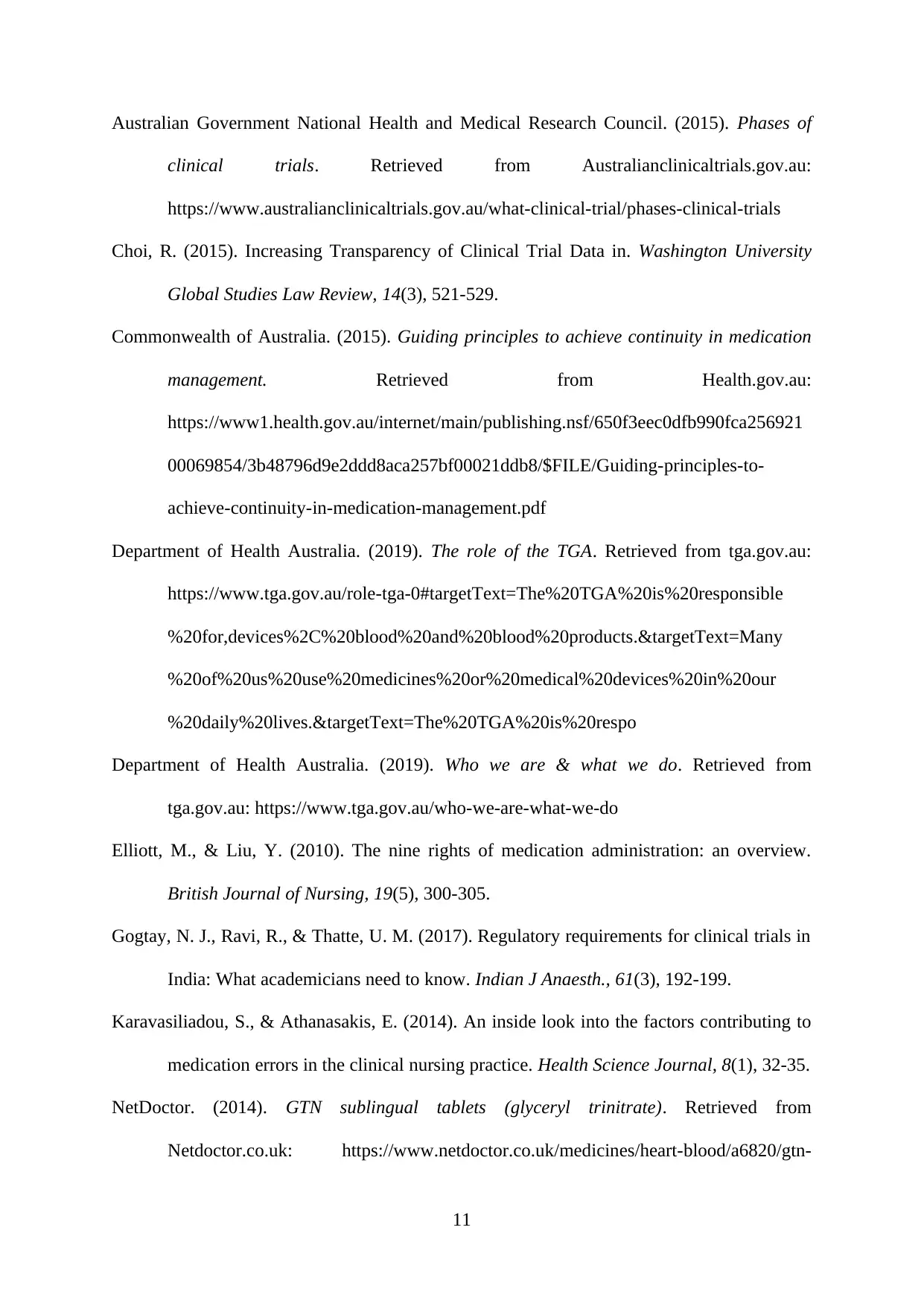
Australian Government National Health and Medical Research Council. (2015). Phases of
clinical trials. Retrieved from Australianclinicaltrials.gov.au:
https://www.australianclinicaltrials.gov.au/what-clinical-trial/phases-clinical-trials
Choi, R. (2015). Increasing Transparency of Clinical Trial Data in. Washington University
Global Studies Law Review, 14(3), 521-529.
Commonwealth of Australia. (2015). Guiding principles to achieve continuity in medication
management. Retrieved from Health.gov.au:
https://www1.health.gov.au/internet/main/publishing.nsf/650f3eec0dfb990fca256921
00069854/3b48796d9e2ddd8aca257bf00021ddb8/$FILE/Guiding-principles-to-
achieve-continuity-in-medication-management.pdf
Department of Health Australia. (2019). The role of the TGA. Retrieved from tga.gov.au:
https://www.tga.gov.au/role-tga-0#targetText=The%20TGA%20is%20responsible
%20for,devices%2C%20blood%20and%20blood%20products.&targetText=Many
%20of%20us%20use%20medicines%20or%20medical%20devices%20in%20our
%20daily%20lives.&targetText=The%20TGA%20is%20respo
Department of Health Australia. (2019). Who we are & what we do. Retrieved from
tga.gov.au: https://www.tga.gov.au/who-we-are-what-we-do
Elliott, M., & Liu, Y. (2010). The nine rights of medication administration: an overview.
British Journal of Nursing, 19(5), 300-305.
Gogtay, N. J., Ravi, R., & Thatte, U. M. (2017). Regulatory requirements for clinical trials in
India: What academicians need to know. Indian J Anaesth., 61(3), 192-199.
Karavasiliadou, S., & Athanasakis, E. (2014). An inside look into the factors contributing to
medication errors in the clinical nursing practice. Health Science Journal, 8(1), 32-35.
NetDoctor. (2014). GTN sublingual tablets (glyceryl trinitrate). Retrieved from
Netdoctor.co.uk: https://www.netdoctor.co.uk/medicines/heart-blood/a6820/gtn-
11
clinical trials. Retrieved from Australianclinicaltrials.gov.au:
https://www.australianclinicaltrials.gov.au/what-clinical-trial/phases-clinical-trials
Choi, R. (2015). Increasing Transparency of Clinical Trial Data in. Washington University
Global Studies Law Review, 14(3), 521-529.
Commonwealth of Australia. (2015). Guiding principles to achieve continuity in medication
management. Retrieved from Health.gov.au:
https://www1.health.gov.au/internet/main/publishing.nsf/650f3eec0dfb990fca256921
00069854/3b48796d9e2ddd8aca257bf00021ddb8/$FILE/Guiding-principles-to-
achieve-continuity-in-medication-management.pdf
Department of Health Australia. (2019). The role of the TGA. Retrieved from tga.gov.au:
https://www.tga.gov.au/role-tga-0#targetText=The%20TGA%20is%20responsible
%20for,devices%2C%20blood%20and%20blood%20products.&targetText=Many
%20of%20us%20use%20medicines%20or%20medical%20devices%20in%20our
%20daily%20lives.&targetText=The%20TGA%20is%20respo
Department of Health Australia. (2019). Who we are & what we do. Retrieved from
tga.gov.au: https://www.tga.gov.au/who-we-are-what-we-do
Elliott, M., & Liu, Y. (2010). The nine rights of medication administration: an overview.
British Journal of Nursing, 19(5), 300-305.
Gogtay, N. J., Ravi, R., & Thatte, U. M. (2017). Regulatory requirements for clinical trials in
India: What academicians need to know. Indian J Anaesth., 61(3), 192-199.
Karavasiliadou, S., & Athanasakis, E. (2014). An inside look into the factors contributing to
medication errors in the clinical nursing practice. Health Science Journal, 8(1), 32-35.
NetDoctor. (2014). GTN sublingual tablets (glyceryl trinitrate). Retrieved from
Netdoctor.co.uk: https://www.netdoctor.co.uk/medicines/heart-blood/a6820/gtn-
11
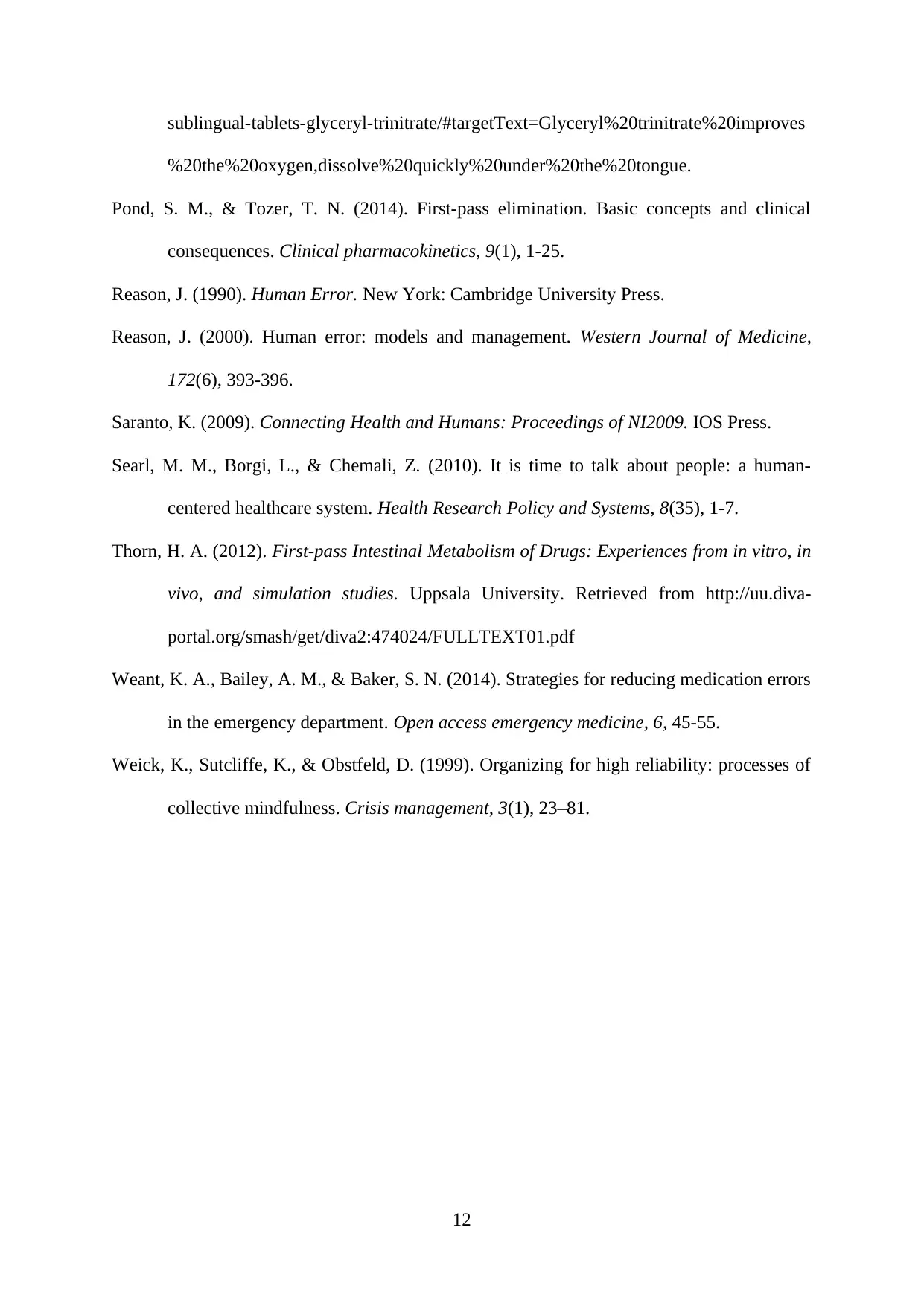
sublingual-tablets-glyceryl-trinitrate/#targetText=Glyceryl%20trinitrate%20improves
%20the%20oxygen,dissolve%20quickly%20under%20the%20tongue.
Pond, S. M., & Tozer, T. N. (2014). First-pass elimination. Basic concepts and clinical
consequences. Clinical pharmacokinetics, 9(1), 1-25.
Reason, J. (1990). Human Error. New York: Cambridge University Press.
Reason, J. (2000). Human error: models and management. Western Journal of Medicine,
172(6), 393-396.
Saranto, K. (2009). Connecting Health and Humans: Proceedings of NI2009. IOS Press.
Searl, M. M., Borgi, L., & Chemali, Z. (2010). It is time to talk about people: a human-
centered healthcare system. Health Research Policy and Systems, 8(35), 1-7.
Thorn, H. A. (2012). First-pass Intestinal Metabolism of Drugs: Experiences from in vitro, in
vivo, and simulation studies. Uppsala University. Retrieved from http://uu.diva-
portal.org/smash/get/diva2:474024/FULLTEXT01.pdf
Weant, K. A., Bailey, A. M., & Baker, S. N. (2014). Strategies for reducing medication errors
in the emergency department. Open access emergency medicine, 6, 45-55.
Weick, K., Sutcliffe, K., & Obstfeld, D. (1999). Organizing for high reliability: processes of
collective mindfulness. Crisis management, 3(1), 23–81.
12
%20the%20oxygen,dissolve%20quickly%20under%20the%20tongue.
Pond, S. M., & Tozer, T. N. (2014). First-pass elimination. Basic concepts and clinical
consequences. Clinical pharmacokinetics, 9(1), 1-25.
Reason, J. (1990). Human Error. New York: Cambridge University Press.
Reason, J. (2000). Human error: models and management. Western Journal of Medicine,
172(6), 393-396.
Saranto, K. (2009). Connecting Health and Humans: Proceedings of NI2009. IOS Press.
Searl, M. M., Borgi, L., & Chemali, Z. (2010). It is time to talk about people: a human-
centered healthcare system. Health Research Policy and Systems, 8(35), 1-7.
Thorn, H. A. (2012). First-pass Intestinal Metabolism of Drugs: Experiences from in vitro, in
vivo, and simulation studies. Uppsala University. Retrieved from http://uu.diva-
portal.org/smash/get/diva2:474024/FULLTEXT01.pdf
Weant, K. A., Bailey, A. M., & Baker, S. N. (2014). Strategies for reducing medication errors
in the emergency department. Open access emergency medicine, 6, 45-55.
Weick, K., Sutcliffe, K., & Obstfeld, D. (1999). Organizing for high reliability: processes of
collective mindfulness. Crisis management, 3(1), 23–81.
12
⊘ This is a preview!⊘
Do you want full access?
Subscribe today to unlock all pages.

Trusted by 1+ million students worldwide
1 out of 12
Related Documents
Your All-in-One AI-Powered Toolkit for Academic Success.
+13062052269
info@desklib.com
Available 24*7 on WhatsApp / Email
![[object Object]](/_next/static/media/star-bottom.7253800d.svg)
Unlock your academic potential
Copyright © 2020–2025 A2Z Services. All Rights Reserved. Developed and managed by ZUCOL.





